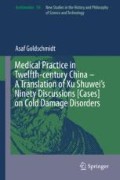Abstract
In the discussion adjoining the case Xu outlines some basic notions concerning Cold Damage disorders. He states that doctors need to determine the extent of the pathogen’s penetration into the body and then decide on the correct treatment.
Access this chapter
Tax calculation will be finalised at checkout
Purchases are for personal use only
Notes
- 1.
Thoracic Fullness refers to either a symptom of distension of the chest or to an Immature Yin syndrome. See Zhongyi da cidian, 2nd ed., p. 1450.
- 2.
- 3.
See Scheid et al. 2009, pp. 104–109.
- 4.
Here Xu refers to a syndrome that took a turn for the worse due to mistreatment (the term should actually be ‘Aggrevated Disorder’ huaibing 壞病 not ‘Aggrevated Manifestation Type’ huaizheng 壞證). The same combination is also used when the turn for the worse is due to not providing a timely treatment. See Zhongyi da cidian, 2nd ed., p. 780.
- 5.
Here Xu Shuwei refers to two prescriptions although he does not specify so in the case leaving out the ‘powder’ character. For further information on Oyster Shell Powder see Scheid et al. pp. 420–422; for further information on Frigid Extremities Decoction see Scheid et al. pp. 274–277.
- 6.
Xu Shuwei is using here an alternate name for the formula, which is commonly recorded as chaihu guizhi tang 柴胡桂枝湯. For information on the prescription see Scheid et al. pp. 109–110.
- 7.
Although Xu Shuwei is quoting Zhang Zhongjing, this quotation or even fragments of it do not appear in any of Zhang’s books.
Bibliography
Other Sources:
Mitchell, Craig, Feng Ye, and Nigel Wiseman. 1999. Shang Han Lun (On Cold Damage); Translation and Commentaries. Brookline, MA: Paradigm Publications.
Scheid, Volker, Dan Bensky, Andrew Ellis, and Randall Barolet. 2009. Chinese Herbal Medicine: Formulas and Strategies. Seattle: Eastland Press.
Yu, Bohai 于伯海, et. al. 1997. Shanghan jinkui wenbing mingzhu jicheng 伤寒金匮温病名著集成 [Collected Famous Works on Cold Damage, Golden Casket, and Febrile Disorders]. Beijing, Huaxia chubanshe.
Author information
Authors and Affiliations
Rights and permissions
Copyright information
© 2019 Springer Nature Switzerland AG
About this chapter
Cite this chapter
Goldschmidt, A. (2019). Case Number 33. In: Medical Practice in Twelfth-century China – A Translation of Xu Shuwei’s Ninety Discussions [Cases] on Cold Damage Disorders. Archimedes, vol 54. Springer, Cham. https://doi.org/10.1007/978-3-030-06103-6_34
Download citation
DOI: https://doi.org/10.1007/978-3-030-06103-6_34
Published:
Publisher Name: Springer, Cham
Print ISBN: 978-3-030-06102-9
Online ISBN: 978-3-030-06103-6
eBook Packages: MedicineMedicine (R0)

